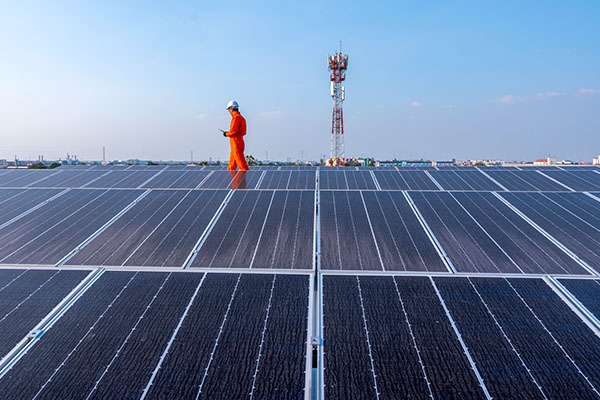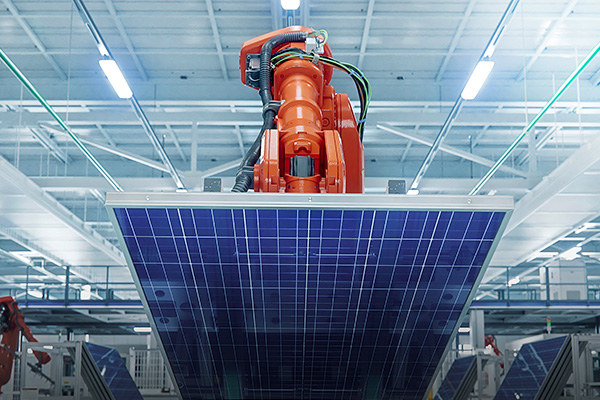Leveraging technology for business sustainability
This post was sponsored by AT&T Business, but the opinions are my own and don’t necessarily represent positions or strategies of AT&T Business.
Today, technology and sustainability are no longer separate concerns. In fact, they’re deeply intertwined. We see this in the massive growth of sustainability technology, which is being used to support environmental sustainability. Or, in other words, to ensure we meet "the needs of the present without compromising the ability of future generations to meet their own needs,” as defined by the UN’s Brundtland Commission back in 1987.
What is sustainability technology?
Sustainability technology (sustainability tech) encompasses a wide range of innovative solutions and practices. Their primary purpose is to address leading Environment, Social, or Governance (ESG) challenges, while also minimizing any negative impacts from their use. ESG is a vast and complex effort. Sustainability tech includes environmental conservation, renewable energy, energy efficiency, waste reduction and recycling. It also includes water conservation, sustainable agriculture, transportation, smart cities, circular economy, and social impact.
Reflecting back to the 1987 definition for sustainability tech, we probably couldn’t have predicted how much technology would one day support meeting current needs without compromising the future. This is especially so in regard to pressing global challenges such as climate change, resource depletion, and environmental degradation. This is more important now that ever.
We’re at a time where multiple environmental sustainability-related vectors of change are integrating and escalating with record speed, scope, and scale. It has been the hugely significant UN Sustainable Development Goals (SDGs) Report 2023: Special Edition that revealed the extent of the challenge. We’re living in the first truly global energy crisis with vectors of change and poly-risk (WEF 2023) both heightening and converging.1
For more context, here are some illuminating recent findings that bring the high value of sustainability action, enabled through sustainability tech, center stage:
Global climate trends:
- The last 8 years were the warmest on record, finds the World Meteorological Organization’s ‘State of the Climate’ report 2
- Average sea levels have risen over 8 inches since 1880, with around three of those gained in the last 25 years alone (WMO)2
Technology trends:
- Gartner suggests that by 2025, 50% of CIOs will include sustainability metrics in the evaluation of their IT performance3
- Data traffic is up 23% year-over-year—the demand for network speed just continues to grow (Sally Eaves & AT&T Business)4
We’ve seen growth in sustainability tech leadership and co-creation to meet ESG needs. An example the Connected Learning Center program by AT&T to help bridge the digital divide. This is defined as the sizable gap between those who have access to computers and the internet and those who do not.
But we can’t talk about sustainability tech without noting that computing is still a contributor to problems such as carbon emissions. Computing is responsible for between 1.8% and 3.9% of greenhouse gas (GHG) emissions worldwide. Indeed, the carbon footprint of IT operations directly impact a company's GHG emissions with enterprise technology responsible for approximately 1% according to McKinsey’s recent study.5
But equally, computing and IT can also help address ESG challenges too. Moreover, I believe that the purposeful application of technology can be the leading catalyst for positive change. So, what does this take in practice?
Building sustainability so that all parties benefit is important. This can also make these efforts a catalyst to gain a competitive advantage. For this, it’s critical that technology and data are integrated from the very beginning. And it also makes it necessary to consider the strategic application—the how and where sustainability tech is applied—not 'adoption for adoption’s sake’. Here’s how it might look in corporate life when these critical considerations are part of the design.
The layers of corporate sustainability
Fragmentation gets in the way of progress! In other words, sustainability needs to be part of every element of our corporate organizations. To support the growing call for more co-creation and collaboration, we must reduce fragmentation at the individual business level as a key starting point. Corporate environmental sustainability reflects the multifaceted layers that organizations must navigate to minimize the negative impact of business on the environment, economy, and society at large, while maximizing its positive contributions.
These levels typically include environmental, social, and economic sustainability, governance and ethics, innovation and technology, risk management, stakeholder engagement, and sustainable finance. Each of these dimensions is highly interconnected. It’ll take a holistic approach for organizations to become truly sustainable.
Sustainability governance and regulation
It has always been a challenge to balance harnessing the power of technological advancement and mitigating its potential risks. Catalyzed by the scale and speed of technology and ESG change, as expected, governance and regulation has risen to hold this balance.
Sustainability tech governance is a growing and evolving field, however, and it requires collaboration between governments, businesses, civil society, and individuals to advance change. It’s key to develop a common language and framework for these entities to work together. This can be supported by standardization bodies that develop technical standards to help ensure the interoperability, compatibility, and efficiency of sustainable technologies. For example, the Institute of Electrical and Electronics Engineers (IEEE) sets standards for renewable energy systems.
Specificity also matters. One example of this approach in action is the consultative evolution around the Environmental Protection Agency (EPA) laws and regulations.6 The new reporting requirements this institution has put in place will help protect and preserve the environment and public health. It can help meet some of the rising demands for rigorous and measurement-informed accounting for carbon emissions.
These regulations cover areas including environmental protection, air quality, water quality, hazardous waste management, and chemical safety. EPA regulations impact greenhouse gas emissions as well. They directly affect Scope 1 through standards and limits, indirectly affect Scope 2 by regulating electricity generation, and can also indirectly influence Scope 3 by encouraging more sustainable practices across an organization’s value chain.7

Driving business success through sustainability
Stay ahead of regulations and reduce energy and resource consumption. Learn why sustainability is important for business and staying resilient in a crisis.
The critical role of technology in business sustainability
How and where IT uses technology is critical. The role it plays is pivotal in enabling a business sustainability model that can scale. Their approach must be strategic. Today we’re seeing roles like the Director of Sustainability are beginning to ‘sit’ under the Office of the Chief Technology Officer (CTO), along with expanding requirements for CIOs.8
Beyond IT efficiency, these positions are growing in influence. In addition to IT efficiency, they’re driving ESG sustainability within technology. And with technology supporting almost every aspect of our daily lives, ESG really should be no different!
Here is my personal guide covering the latest innovations in or supporting sustainability tech, including:
- Network reliability and efficiency
- Software-defined wide area networking (SD-WAN)
- 5G
- Internet of Things (IoT)
- Voice and collaboration (V&C)
- MicroGrid technology
- New materials
- Repurposed technology
1. Network reliability and efficiency
Achieving network sustainability involves using energy-efficient hardware, optimizing data centers, adopting renewable energy sources, reducing e-waste through recycling and responsible disposal, and designing networks with energy-efficient protocols.
Ensuring network reliability and efficiency must include tailorability to organizations of all sizes, utilizing best-fit solutions across ethernet, business Wi-Fi, and SD-WAN, as demonstrated by the AT&T Business award-winning networking solutions.
In particular, SD-WAN affords multiple sustainability benefits. This technology can help organizations reduce their environmental impact in multiple ways:
SD-WAN – Sustainability in focus
Energy efficiency: SD-WAN can optimize network traffic and reduce the need for excessive data routing, leading to more efficient use of network infrastructure. This can result in lower energy consumption for network equipment, such as routers and switches.
Reduced hardware: SD-WAN allows for the consolidation of network hardware and the use of virtualized network functions, reducing the need for physical equipment. This not only saves space but also reduces the environmental impact associated with manufacturing, shipping, and disposing of hardware.
Optimized data traffic: SD-WAN intelligently routes traffic over the most efficient and cost-effective network paths. This can minimize the use of high-carbon footprint connections, such as those powered by fossil fuels, in favor of more eco-friendly options like fiber or renewable energy-powered networks.
Remote work enablement: The flexibility of SD-WAN enables remote work and telecommuting, reducing the need for daily commuting and associated emissions. This can also lead to reduced office space requirements and energy consumption in physical office locations.
Dynamic bandwidth management: SD-WAN allows for dynamic allocation of bandwidth based on real-time needs. This means that during periods of low demand, bandwidth can be scaled down, reducing energy consumption and costs.
Improved collaboration tools: SD-WAN's support for enhanced communication and collaboration tools can reduce the need for business travel. This can lead to lower carbon emissions associated with air travel and commuting.
Disaster recovery and resilience: SD-WAN can improve network resilience and disaster recovery capabilities, reducing downtime in the event of network outages. This not only enhances business continuity but also minimizes the environmental impact of disruptions.
Centralized management: SD-WAN provides centralized control and monitoring of network resources, allowing for better optimization and reducing the need for on-site IT staff and travel for network maintenance.
Environmentally sustainable data centers: Organizations can leverage SD-WAN to connect to environmentally sustainable (often referred to as green data centers) or cloud providers that use renewable energy sources to power their infrastructure. This choice can significantly reduce the carbon footprint associated with data processing and storage.
Monitoring and reporting: SD-WAN solutions often include robust monitoring and reporting features that can help organizations track their environmental performance and identify areas for further improvement.
By adopting SD-WAN technology and optimizing network infrastructure, organizations can reduce their energy consumption and lower their carbon footprint. It's important to note too that the extent of these benefits will depend on the specific implementation and usage of SD-WAN by each organization.
2. 5G and MEC
5G networks are designed to be more energy-efficient than predecessors, particularly on a per-bit basis. As a result, they can handle more data at a lower energy cost, resulting in a decrease in the greenhouse gas emissions associated with mobile data transfer.
Harnessing the power of 5G solutions for your organization brings multiple benefits. This is exemplified by the recent experience of Indiana’s Purdue University, a leading public research institution that’s focused on the creative use of technology.
Their challenge? Requiring a highly secure, low latency, fast-processing, and reliable mobile network architecture.
Their solution? The launch of the Indiana 5G Zone in partnership with AT&T. Here, researchers can test and develop 5G-enabled technologies, advancing innovation projects.
Multi-access Edge Computing (MEC) is a network architecture concept that brings computational capabilities closer to the data source (users, or things in the context of IoT). By decentralizing the processing tasks from the central data centers to the edge of the network, MEC offers numerous benefits that can contribute to sustainability, including reduced energy consumption in data transport, enhanced renewable energy utilization, efficient resource utilization, infrastructure longevity, smart city and IoT integration, localized data storage, improved resilience and reliability and support for environmentally sustainable applications.
With clear benefits especially in reducing carbon footprints and enhancing the efficiency of data processes, work is advancing to evolve challenges around cumulative cooling needs, the increased number of edge nodes needed and e-waste.
3. IoT
IDC estimates there will be 55.7 billion connected IoT devices by 2025, generating almost 80B Zettabytes of data—a growth rate higher than for traditional IT equipment.9 And this becomes a context far more than connectivity alone, for IoT is the ‘hub of the wheel’ for more efficiently collecting data and undertaking informed action, for example to monitor and optimize energy use in order to reduce carbon footprints. With sustainable development goals (SDG) under pressure and amidst the ongoing energy crisis, IoT-enabled smart energy management will play an increasingly critical role in minimizing energy waste and maximizing sustainability, whilst reducing costs.10
With the help of IoT sensors and analytics, AT&T has developed water management tools that allow for better monitoring and conservation of water resources. Smart water metering enables greater conservation through quicker identification of wasteful leaks alongside arming users with real-time data. You can explore how Badger Meter uses AT&T cellular-enabled devices for benefits across connectivity, security, coverage, cost, experience, waste and conservation here, a brilliant example of this technology in action!
Additional growing opportunities include the convergence of IoT with augmented and virtual reality in climate data visualization. This is especially so by combining sustainable technology with open-source resources to also benefit accessibility and democratization of access. Similarly, IoT paired with artificial intelligence (AI) and machine learning (ML) brings a multitude of benefits, from optimizing power grids to predicting maintenance needs. In regard to ESG more broadly, benefits include data-driven insights, risk management, efficiency gains, transparency, and innovation.
Finally, within IoT come new opportunities to embrace the power of energy harvesting—the process of collecting energy from the environment and converting it into a usable form. This allows the operating life of devices to be extended by reducing or eliminating the need for batteries. In certain cases, it can also make the devices smaller, cheaper and embeddable too!
4. Voice and Collaboration
It may seem strange to call voice and collaboration tools “sustainability tech.” But remote meeting and working capabilities are essential for reducing wasteful travel and enhancing productivity. AT&T Office@Hand is example. It’s a comprehensive unified communications as a service (UCaaS solution). It’s focused on when and how you want to connect—delivering a single, unified phone, video, and messaging platform that works seamlessly across your business devices. This ensures organizations of any size can communicate and collaborate efficiently regardless of the medium. This is all supported by a network that is secure from end-to-end, intelligent and responsive, and of course, reliable no matter where you’re working from.11
Supported by advances across VoIP services and VoIP adapters, Microsoft Team VoIP with Cloud Voice and Mobile Remote Access, Office@Hand offers a holistic portfolio of trusted services. It also benefits from the support of experts who know business and can help reduce complexity, personalize fit, control costs, negate waste, and enable friction-free collaboration from anywhere. Additional benefits include more purposeful travel, an increase in telecommuting and the reduced carbon emissions that result.
5. MicroGrid Tech
From blackout resilience to renewable integration, microgrids are a game-changer, especially when addressing the challenges of aging power infrastructure, climate change, and energy scarcity as I recently discussed.12
Microgrid technology refers to the localized and often decentralized system of generating, distributing, and managing electricity. It’s designed to provide reliable and resilient power to a specific area, such as a neighborhood, campus, industrial complex, or even a military base. Microgrids are becoming increasingly popular due to their ability to enhance energy security, reduce greenhouse gas emissions, and improve the integration of renewable energy sources.
6. New materials
From material engineering and synthetic biology, through to digital fabrication and computational design, the field of materials innovation is rapidly revolutionizing sustainability tech
Recent examples reflect the diversity in scope. They include ground-breaking energy-efficient chip designs and the advance of Smart Membranes whose fluid connections afford eco-friendly innovation, supporting industries to transform for a more environmentally sustainable future.
7. Repurposed tech
When we think about sustainability tech it’s important to stress that often we can do more with less, or more with what we have! According to McKinsey, taking immediate action to advance the sustainability of data and software can result in a reduction of approximately 5% in Co2 emissions by 2030 alone!13
Developments in environmentally sustainable software engineering, eco-friendly app development, essential standards, and ecoCode plugins are very relevant here. Further examples of repurposing include turning waste into compost and a battery harnessed from agricultural waste. Brilliant!
Evaluating your business for sustainable technology solutions
Creating a sustainable technology roadmap for your business is critical in a landscape where environmental concerns and sustainable practices are increasingly intertwined with business success. Within this it’s useful to reflect that part of your evaluation could also include the use of re-manufactured technology versus new, especially for SMEs.
Above all, a sustainable technology roadmap requires careful planning, collaboration, and ongoing assessment. It's a living document that should evolve with technological advancements and the changing landscape of sustainability in business, ensuring technology and sustainability strategies are aligned.
Your sustainable technology roadmap
In conclusion, here's a step-by-step practical guide to evaluating your business for sustainable technology solutions and developing a roadmap for success. Wishing you every success in your journey. All questions and feedback most welcome!
1. Define your vision and objectives
Vision: Start by establishing a clear, long-term vision for sustainability within your business.
Objectives: Break this vision down into specific, measurable, achievable, relevant, and time-bound (SMART) objectives.
2. Assess your current state
Tech audit: Review the current technology stack and solutions in place.
Environmental impact: Understand the carbon footprint or environmental impact of your existing solutions.
Gap analysis: Identify where you fall short in achieving your sustainability vision.
3. Research sustainable solutions
Emerging Technologies: Explore solutions like cloud computing, environmentally sustainable data centers, and energy-efficient hardware.
Eco-friendly Vendors: Collaborate with vendors offering sustainable products and services.
Best Practices: Stay updated with sustainable technology practices relevant to your industry.
4. Prioritize initiatives
Immediate Impact: Identify solutions that can deliver immediate sustainability benefits.
Cost vs. Benefit: Evaluate the potential cost and sustainability benefits of each initiative.
Risks: Assess any potential risks, whether technological, financial, or operational.
5. Engage stakeholders
Internal engagement: Involve employees, management, and key decision-makers.
External engagement: Engage customers, suppliers, and partners in your sustainable journey.
6. Set short-term and long-term milestones
Quick Wins: Identify low-hanging fruits that can show immediate results.
Phased Approach: Design a phased implementation plan for long-term goals.
7. Implement solutions
Training: Ensure employees are equipped with the skills and knowledge to use new technologies effectively.
Monitoring: Use monitoring tools to track the environmental impact of new solutions.
Feedback loops: Establish mechanisms to collect feedback and adjust strategies accordingly.
8. Monitor, measure, and iterate
KPIs: Define key performance indicators (KPIs) to measure the success of each initiative.
Regular review: Continuously review and adjust the roadmap based on results and changing business conditions.
Share success: Celebrate and communicate your sustainable achievements both internally and externally.
9. Foster a sustainable culture
Education: Regularly update and educate your teams on sustainable practices.
Rewards: Recognize and reward those who contribute significantly to your sustainability goals.
Feedback: Encourage employees to come up with innovative sustainable solutions.
10. Update roadmap periodically
Stay updated: As new sustainable technologies emerge, reassess and realign your roadmap.
Scalability: Ensure your roadmap can accommodate business growth without compromising sustainability goals.
Bonus Tips!!!
Collaborate: Join sustainable business networks or forums to collaborate and share knowledge.
Transparency: Be open about your sustainability goals, progress, and challenges. This can foster trust among stakeholders.
Regulations: Stay updated on environmental regulations and ensure compliance.
Why AT&T Business
See how ultra-fast, reliable fiber and 5G connectivity protected by built-in security give you a new level of confidence in the possibilities of your network. Let our experts work with you to solve your challenges and accelerate outcomes. Your business deserves the AT&T Business difference—a new standard for networking.
Learn more about AT&T Business products and solutions or contact your AT&T Business representative to connect with an expert who knows business.
1“The Sustainable Development Goals Report sos3: Special Edition.” United Nations, July 10, 2023, https://unstats.un.org/sdgs/report/2023/.
2“State of the Global Climate 2022,” World Meteorological Report, Accessed September 19, 2023, https://storymaps.arcgis.com/stories/6d9fcb0709f64904aee371eac09afbdf.
3Jackie Wiles, “Are You Thinking Too Small About Sustainable Technology?,” Gartner, September 27, 2022, https://www.gartner.com/en/articles/are-you-thinking-too-small-about-sustainable-technology.
4Sally Eaves, “RSA: 2023 and Beyond with AT&T Business – A New Standard for Networking: Security is at the Network!, LinkedIn, June 28, 2023, https://www.linkedin.com/pulse/rsa-2023-beyond-att-business-new-standard-networking-security-eaves.
5“The green IT revolution: A blueprint for CIOs to combat climate change,” McKinsey, September 15, 2022, https://www.mckinsey.com/capabilities/mckinsey-digital/our-insights/the-green-it-revolution-a-blueprint-for-cios-to-combat-climate-change.
6“Get Involved with EPA Regulations,” Environmental Protection Agency, Accessed September 20, 2023, https://www.epa.gov/laws-regulations/get-involved-epa-regulations.
7“Definitions of Scope 1, 2, and 3 emissions,” NationalGrid, Accessed September 20, 2023, https://www.nationalgrid.com/stories/energy-explained/what-are-scope-1-2-3-carbon-emissions.
8Sally Eaves, “The CIO Reimagined Data Centricity, Human-Centered Leadership and Skills-Based Organization The Catalysts for Shared Value Innovation – Part 2,” LinkedIn, March 27, 2023, https://www.linkedin.com/pulse/cio-reimagined-data-centricity-human-centered-leadership-sally-eaves-1e/
9“Future of Industry Ecosystems: Shared Data and Insights,” IDC, January 6, 2021, https://blogs.idc.com/2021/01/06/future-of-industry-ecosystems-shared-data-and-insights/.
10“IoT-based smart energy management,” Onio, Accessed September 20, 2023, https://www.onio.com/article/global-energy-crisis-underway-iot-can-help.html.
11Sally Eaves, RSA 2023 and Beyond with AT&T Business – A New Standard for Networking: Security is the Network!,” LinkedIn, June 28, 2023, https://www.linkedin.com/pulse/rsa-2023-beyond-att-business-new-standard-networking-security-eaves.
12Sally Eaves, “Security in the Energy Industry with Microsoft,” LinkedIn, March 20, 2023, https://www.linkedin.com/pulse/security-energy-industry-microsoft-sally-eaves/.
13Louise Herring, Madeline Malmstein, Christoph Sporleder, and Nikhl Srinidhi, “Making software and data architectures more sustainable,” McKinsey, https://www.mckinsey.com/capabilities/mckinsey-digital/our-insights/tech-forward/making-software-and-data-architectures-more-sustainable.



